Lenovo Re-Engineers ThinkPad X1 Tablet: 13-inch LCD, Quad-Core i7, TB3, 9.5 Hrs
by Anton Shilov on January 8, 2018 8:01 PM EST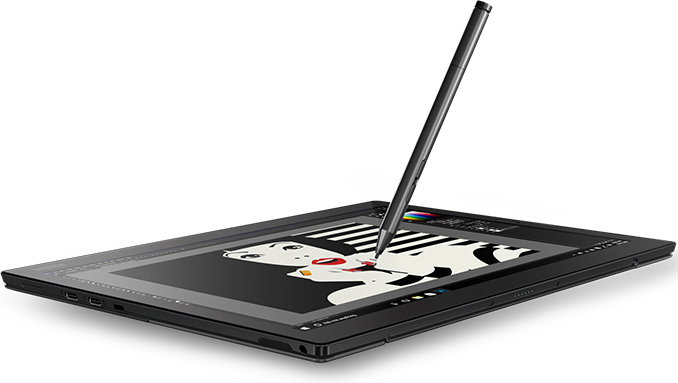
LAS VEGAS, NV — Lenovo has announced its third iteration of the ThinkPad X1 Tablet. The new system is a complete departure from the two prior generations of the ThinkPad X1 Tablets as it uses fully-fledged Intel’s Core i7 CPUs instead of their low-power Y-series counterparts, has a large 13” display, two Thunderbolt 3 ports and no longer supports expansion modules.
The most noticeable upgrade of the Lenovo ThinkPad X1 Tablet 3rd Gen when compared to its predecessors and direct rivals is, of course, its 13” IPS touchscreen that has a 3000×2000 resolution (thus retaining a 3:2 aspect ratio) as well as 10-point multi-touch and pen support. The larger display with a higher resolution and pixel density vs. competitors (primarily the Surface Pro 2017) will certainly be among the main selling points of the new X1T. The improvements do not end here.
Just like the other ThinkPad X1-branded mobile PCs announced at CES 2018, the ThinkPad X1 Tablet is based on Intel’s 8th Generation quad-core Core i7 CPU with integrated UHD Graphics 620 iGPU. The new SoC is a major progress for the new ThinkPad X1 Tablet. The previous-gen ThinkPad X1T featured a Kaby Lake-Y SoC with two cores and an iGPU running at relatively low frequencies to save power. By contrast, the new SoC packs four cores and faster graphics, a performance boost across the board. Unfortunately for graphics professionals seeking for a higher-performing iGPU, there will be no X1Ts with the Iris Plus Graphics 640 found inside Microsoft’s premium Surface Pro 2017 as there are no Intel’s 8th Gen Core i7 processors with a GT3e-class iGPU. As for RAM and storage, the ThinkPad X1 Tablet can be equipped with up to 16 GB of LPDDR3 and a PCIe NVMe SSD of up to 1 TB.
Moving on to other hardware features of the third-generation ThinkPad X1 Tablet. The system ditches USB Type-A headers but has two Thunderbolt 3 ports (one supporting USB PowerDelivery 3.0 spec), a microSD card reader, a webcam (with or without IR capability for Windows Hello), a rear camera, and a TRRS headphone jack. As for wireless connections, the new X1T has an Intel 802.11ac Wi-Fi + Bluetooth 4.2 module as well as an optional Sierra Wireless EM7455 or EM7430 LTE-A CAT6 modem. None of the new X1T SKUs will feature WiGig technology.
In addition to WiGig support, Lenovo is also ditching support for expansion modules used by the first two generations of the ThinkPad X1 Tablets. Since the mobile PCs now have two TB3/USB-C ports, it is doubtful that Lenovo’s users will have problems finding expansions relying on these interfaces. Some customers might miss the productivity module containing an extra accumulator along with a USB Type-A connector, but 9.5 hours of battery life claimed for the new X1T by Lenovo is a lot for a tablet anyway.
Major performance improvements along with the larger display affected dimensions and weight of the new ThinkPad X1 Tablet. Obviously, the new slate got a bit bigger than its predecessor because of its 13” LCD, but it remained pretty thin in general: its thickness is 8.9 mm, up only 5% vs. the X1T 2nd Gen (which was 8.45 mm). Meanwhile, the new tablet now weighs 890 grams (1.9 lbs), up 16% from 767 grams (1.69 lbs) of the predecessor. While 0.45 mm is not a big deal (especially considering how much extra performance you gain with the new unit), additional 123 grams do not look like a good deal here for those who plan to use the X1T 3rd Gen as a tablet. Moreover, the whole system weighs 1.27 kilograms (2.79 lbs) when the keyboard is added, which is higher than the weight of the new ThinkPad X1 Carbon that has a bigger and, presumably, brighter display. To compensate for the higher weight and larger dimensions as well as to make the whole system a bit more stable when used in laptop mode with a stylus, the latest X1T has a new kickstand that looks stronger than its predecessor.
| Lenovo's ThinkPad X1 Tablet: Gen 3 vs. Gen 2 | |||
| ThinkPad X1 Tablet 3rd Gen | ThinkPad X1 Tablet 2nd Gen | ||
| Display | 13" IPS 3000×2000 277 PPI |
12" IPS 2160×1440 216 PPI |
|
| CPU | Exact CPU models TBC Intel Core i7-8650U (4C/8T, 1.9 - 4.2 GHz) Intel Core i7-8550U (4C/8T, 1.8 - 4.0 GHz) Intel Core i5-8350U (4C/8T, 1.7 - 3.6 GHz) Intel Core i5-8250U (4C/8T, 1.6 - 3.4 GHz) TDP: 15 W Select SKUs powered by vPro CPUs |
Intel Core i7-7Y75 (2C/4T, 1.3 - 3.6 GHz) Intel Core i5-7Y57 2C/4T, 1.2 - 3.3 GHz) Intel Core i5-7Y54 (2C/4T, 1.2 - 3.2 GHz) TDP: 4.5 W Select SKUs powered by vPro CPUs |
|
| Graphics | i7 UHD 620: 24 EUs at 300 - 1150 MHz i5 UHD 620: 24 EUs at 300 - 1100 MHz |
i7 HD 615: 24 EUs at 300 - 1050 MHz i5 HD 615: 24 EUs at 300 - 950 MHz |
|
| RAM | up to 16 GB LPDDR3 | ||
| Storage | up to 1 TB PCIe SSD | ||
| Wi-Fi | Intel 2×2 802.11ac Wi-Fi | ||
| Bluetooth | Bluetooth 4.2 | Bluetooth 4.1 | |
| WWAN | Sierra Wireless EM7455 or EM7430 LTE-A CAT6 modem |
Qualcomm X7 LTE or Sierra Wireless 7455 |
|
| Thunderbolt | 2 × USB Type-C TB3 ports | - | |
| USB | 3.1 | 2 × Type-C (via TB3) | - |
| 3.0 | - | 1 × Type-A 1 × Type-C |
|
| Display Outputs | DisplayPort over TB3/USB-C | 1 × Mini DisplayPort | |
| GbE | - | ||
| Fingerprint Sensor | Yes | ||
| Cameras | Rear: ? Front: ? |
Rear: 8 MP Front: 2 MP |
|
| Other I/O | Microphone, stereo speakers, audio jack, Utranav, trackpad, card reader, etc. | ||
| Battery | unknown | unknown | |
| Battery Life | 9.5 hours | 10 hours 15 hours with Productivity Module |
|
| Width | 304 mm | 11.45" | 291.5 mm | 11.4" | |
| Height | 226 mm | 8.24" | 209.5 mm | 8.2" | |
| Thickness | 8.9 mm | 0.34" | 8.45 mm | 0.3" | |
| Weight | 890 grams | 1.9 lbs | 767 grams | 1.69 lbs | |
Lenovo’s ThinkPad X1 Tablet 3rd Gen will go on sale this month and will cost starting from $1599 with a keyboard and a pen included.
Related Reading:
- Lenovo Unveils New ThinkPad X1 Carbon, X1 Yoga Laptops: 8th Gen Core, Dolby Vision HDR
- Lenovo’s New ThinkPad Laptops Get Universal USB-C Power Adapters
- Lenovo Updates The X1 Lineup: Thin Bezel X1 Carbon, X1 Yoga And X1 Tablet Updates
- Lenovo’s ThinkPad T580 Launched: Quad-Core CPU, 4K LCD, 32 GB RAM, Up To 27 Hrs Battery Life
- ThinkPad Anniversary Edition 25: Limited Edition ThinkPad Goes Retro
- Lenovo Launches New ThinkPad Accessories: Docking And Displays
Source: Lenovo


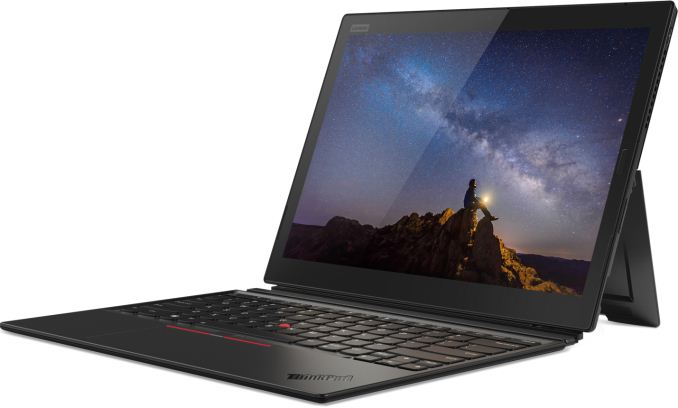
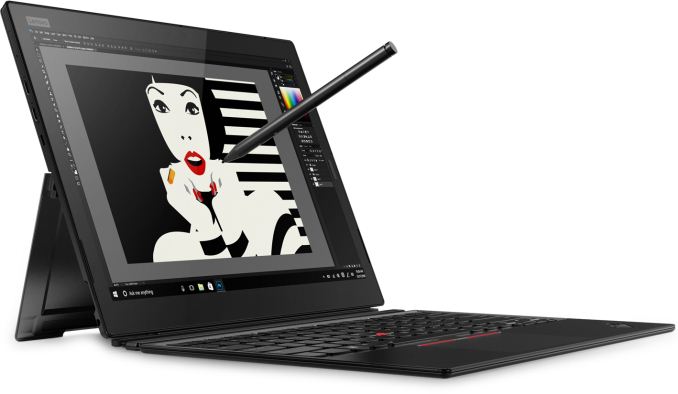
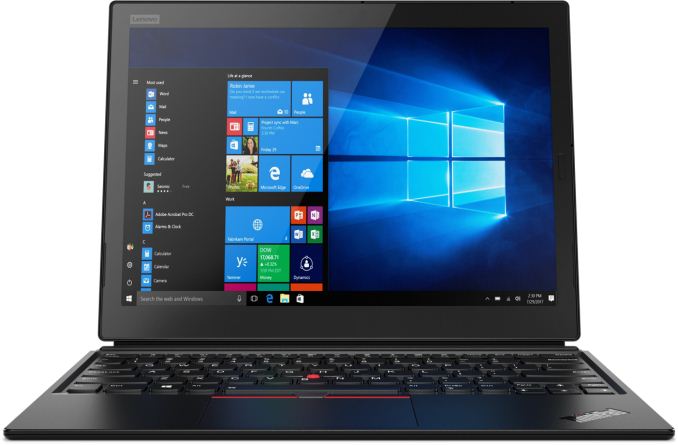
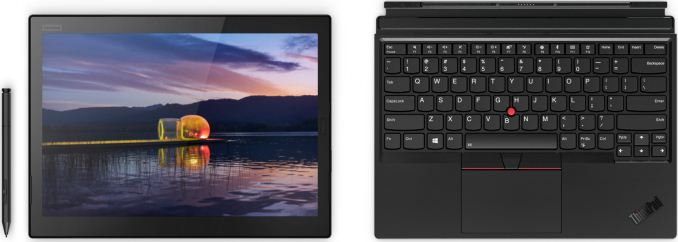







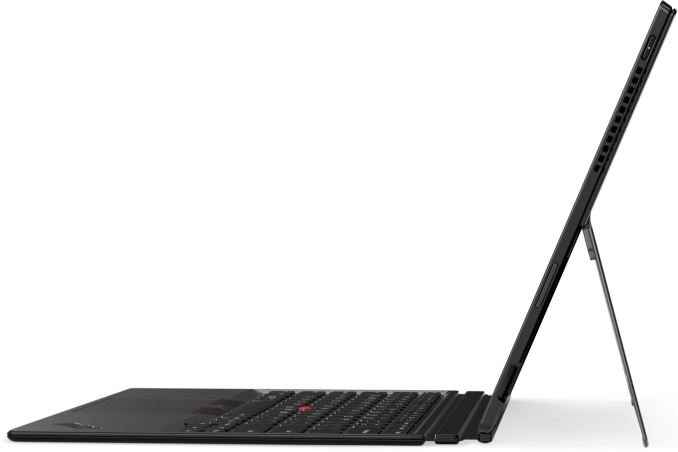








23 Comments
View All Comments
digiguy - Tuesday, January 9, 2018 - link
Man my 2017 Notebook 9 13.3° has hdr....HuShifang - Friday, January 12, 2018 - link
Don't know if it's accurate, but from https://www.digitaltrends.com/computing/lenovo-int... : "Like its siblings, the X1 Tablet’s display supports Dolby Vision HDR and extreme brightness, promising incredibly dynamic colors."JoJ - Wednesday, January 31, 2018 - link
Thanks for that link!I now just need a battery expansion rugged case.
piroroadkill - Tuesday, January 9, 2018 - link
Now put that panel in a solidly built laptop.Valantar - Tuesday, January 9, 2018 - link
Seconded. My suggestion: ThinkPad X1 Yoga update. With the same 25W cooling capacity as before, a beefy battery, and preferably a Ryzen option.Valantar - Tuesday, January 9, 2018 - link
This looks really sweet, but I for one would want a Ryzen mobile chip in there. Would be good for Photshop, Lightroom and other GPU-accelerated apps.digiguy - Tuesday, January 9, 2018 - link
9.5 hours? LOL Last year was supposed to be 10 hours and barely lasted 5... And fan noise remains to be tested (the acer 13.5" tablet is fanless with the same CPU)mooninite - Wednesday, January 10, 2018 - link
We are never going to see Iris graphics in a laptop again after Haswell are we? Disappointing.DSGT_Crockett - Thursday, January 18, 2018 - link
As a Tablet-PC fanatic, I'm already turned off by the "slim, light!"-pandering profile and deeply suspicious that this is another AES digitizer offering (like 95% of their previous Tablet-PC attempts); nobody wants to build the convertible Tablet-PC users overwhelmingly _want_: the most-capable, most-powerful, most-futureproofed workstation that money can make. When the machine I'm typing this on finally bites the dust (heavens forbid), the nearest I can come is buying the most-unadorned near-desktop-spec-withut-actually-using-desktop-parts 'gaming laptop' for seven or eight grand and supplementing *that* with either a similar-footprint Cintiq or viciously-overpriced and -underspecced Wacom MobileStudio, to the tune of an *additional* $1,500-$3K, and throwing portability all but out the damned window. As things sit, I might be able to deal with the extreme latter, but to have no ability to buy a Tablet-PC both with current-spec Wacom EMR digitiser, anything near a decent monitor, and enough grunt to power everything I might conceivably want to do with it (which I'll admit is asking a lot) out to ~5 years, that's not what anyone's building anymore. They're trying to merely undersell fu████g MacBook Pros that they think 'creative types' show up with at 18 to art schools. And bully for them if they do (which almost anybody's been doing for a decade at least); but woe fu███n' betide them if they think there isn't an entire cadre of professionals and amateurs alike sitting on their hands, using 5-10-year-old hardware hoping someone will allow them to, at damn near whatever cost, upgrade to something that has a chance of lasting them as long. No matter what you come with, you can't do that with the hot-stove passive-cooling cases someone in 2009 told you were "stylish", and you can't sell it to us unless they come with CURRENT-mobile-workstation-grade specs, and the room and thoughtfulness of design to keep it as cool as possible with Mudbox/Painter/ZBrush/MODO, Poser, photo- & vector-editing apps as well as an unseemly amount of browser windows open, or even (gasp) attempting to run recent games thereupon. We need discrete graphics, we need the highest-performance chipsets and latecomer-i7/i9 CPUs, we need wide and fast DRAM accomodation, SB buses and an awful lot more connectors to (through?) it than you typically build into laptops. Nobody gives a good goddamn about how much it weighs or whether it's a couple inches smaller in profile than anything else. In fact, we want the opposite: I'll gladly take a bit of bulk in return for a cooler-/faster-running, more robust, more capable machine, at any juncture, without exception, period. All these companies have to do is a systematic review of the past Windows Tablet-PCs they've sold the past ten, twelve years; I'll wager a good 85% or more were custom-configured and done so in such a way as to maximise capability. I'd also bet a lot of people having ordered those are still using them, as there's no way really to replace them. Take this casual-tablet novelty crap elsewhere and bury it. Give us what we want, need, even, and we'll gladly pay your premiums.JoJ - Wednesday, January 31, 2018 - link
I was told 25 years ago by the then recently former marketing director of a large PC vendor, that the first big job he had was undoing bad statistics caused by failure to record the actions and effects of corporate sales negotiations deals, where the high feature products got over represented because fat margins could make dramatic drop close deals for target hungry sales reps, whilst really basic models were underrepresented because of the warranty costs that corporate customers wouldn't purchase without had become the largest line item in the bill of materials, meaning that the buyer wanted cheaper warranty and more basic SKUs or even for the vendor to increase the minimum spec but pay via immediately deductable services expenses like warranty deals. Finding out what caused each model to really sell was a tough little job, like I reckon getting any well oiled sales division to spill their main advantages of gaining commissions should always be.HDR displays I expected to be in huge demand by corporate tablet purchasing mandates. I have never seen such enthusiasm for a device as for Surface 4 in daylight noon sun, and the users of usually rugged tablets, who won't much mind lugging around the battery weight are precisely what should be getting this feature standard for all: find me a roadside engineer or Forrester who doesn't want HDR for plain visibility.